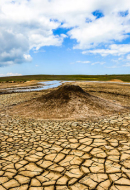Solar radiation
Solar radiation: what is its impact on the planet and on humans?
Solar radiation is the energy emitted by the Sun through electromagnetic waves and life on Earth depends on it. In addition to determining atmospheric and climatological dynamics and trends, it makes plant photosynthesis possible, among other processes. If you want to know more, such as what types of radiation there are and what their harmful effects on health are, especially on the skin in summer, read on.

Without solar radiation, there would be no life on Earth; moreover, it currently allows us to produce photovoltaic energy, which is essential in the fight against climate change. However, it can also be harmful to human health, for example, due to its effects on our skin, and these effects have become more dangerous in recent years due to the greenhouse effect, which also influences the rising temperatures on our planet. Read on to learn about the different types of radiation and how this phenomenon is produced.
What is solar radiation
Solar radiation is the energy emitted by the Sun, which is sent in all directions through space as electromagnetic waves. Emitted by the surface of the Sun, this energy influences atmospheric and climatological processes. It is also, directly and indirectly, responsible for common phenomena, such as plant photosynthesis, keeping the planet at a temperature compatible with life and wind formation, which is essential for generating wind power.
The Sun emits energy in the form of short-wave radiation, which is weakened in the atmosphere by the presence of clouds and absorbed by gas molecules or suspended particles. After passing through the atmosphere, solar radiation reaches the oceanic and continental land surface and is reflected or absorbed. Finally, the surface returns it to outer space in the form of long-wave radiation.
How is solar radiation measured
Solar radiation is measured on a horizontal surface by means of a radiation sensor or pyranometer, which is placed in a south-facing, shadow-free location. Data are collected in units of power, watts per square metre (W/m2), at all weather stations and tend to be taken at ten-minute or 24-hour intervals to establish averages. In the case where it is desired to convert solar radiation from power units to energy units, the data in W/m2 must be multiplied by the number of seconds comprising ten minutes (600) or 24 hours (86,400) and the result will be provided in joules per square metre (J/m2).

How we pollute the environment
Learn about the small daily habits you can change to benefit the planet.

COP29: Climate Summit 2024
Global warming is the cause of extreme natural phenomena.

Greenhouse effect
From desertification to floods.

Climate action
Fight against climate change, driver of our profitable growth strategy.
Types of solar radiation
Depending on the form in which it reaches the Earth:
- Direct solar radiation. This type of radiation penetrates the atmosphere and reaches the Earth's surface without dispersing at all on the way.
- Diffuse solar radiation. This is the radiation that reaches the Earth's surface after having undergone multiple deviations in its trajectory, for example by gases in the atmosphere.
- Reflected solar radiation. This is the fraction of solar radiation that is reflected by the earth's surface itself, in a phenomenon known as the albedo effect.
Depending on the types of light:
- Infrared rays (IR). Longer wavelength than visible light, they emit heat and are given off by any body whose temperature is greater than 0º Kelvin.
- Visible rays (VI). They emit light and are those that the human eye perceives in the form of colours (red, orange, yellow, green, cyan, blue and violet).
- Ultraviolet (UV) rays. They are invisible to the human eye and have the most serious impact on the skin (burns, spots, wrinkles). They are divided into three subcategories:
- Ultraviolet A (UVA). Ultraviolet light that passes through the atmosphere easily, most of it reaching the surface of the planet.
- Ultraviolet B (UVB). This does not penetrate the atmosphere so easily. Even so, it reaches the surface and is responsible for the worst skin damage.
- Ultraviolet C (UVC). This type of ultraviolet radiation cannot get through the atmosphere, because it is absorbed by the ozone layer.
The UV index and the effects of the sun on our skin
Humans are exposed to UV radiation, especially UVA and UVB radiation, which can be dangerous to their skin. One of the ways we have to measure the negative consequences of this type of radiation on people is the global solar UV index (UVI). This index ranges from one to eleven and the higher the index, the greater the likelihood of skin and eye damage.
The UV index and basic photoprotection recommendations
 SEE INFOGRAPHIC: The UV index and basic photoprotection recommendations [PDF] External link, opens in new window.
SEE INFOGRAPHIC: The UV index and basic photoprotection recommendations [PDF] External link, opens in new window.
Among other consequences, it increases the chances of sunburn, premature ageing and even skin cancer, especially in people with a lighter phototype. For this reason, the IUV is an important and differential element in raising public awareness of the risks of excessive exposure, warning of the imminent need to adopt protective measures to minimise the risks. These include:
 Staying out of the sun in the middle of the day and, if there is no alternative, staying in the shade and drinking plenty of water.
Staying out of the sun in the middle of the day and, if there is no alternative, staying in the shade and drinking plenty of water.
 Wearing protective clothing, like hats, caps or carrying parasols to protect the eyes, face and neck, and light garments.
Wearing protective clothing, like hats, caps or carrying parasols to protect the eyes, face and neck, and light garments.
 Wear good quality sunglasses, in other words those with certified lenses and, if possible, with a wraparound design and with side panels.
Wear good quality sunglasses, in other words those with certified lenses and, if possible, with a wraparound design and with side panels.
 Use sun protection cream with a sun protection factor higher than 15, although it is advisable to choose according to the skin phototype, half an hour before exposure. Apply generously and repeat as often as necessary.
Use sun protection cream with a sun protection factor higher than 15, although it is advisable to choose according to the skin phototype, half an hour before exposure. Apply generously and repeat as often as necessary.
"The solar maximum"
Not everything related to the sun’s power has to do with UV rays and sunscreen; this energy also hides other more exciting things. In the summer of 2024 we experienced a phenomenon as exciting as it was spectacular: northern lights almost everywhere in the world. From Denmark to the United States, the colourful lights adorned the sky, giving us the most intense display of auroras recorded in 500 years. For those who missed them, there will be more to come.
According to experts, in 2024 the Sun is reaching a so-called "solar maximum", because the star is producing much more irradiance than usual and is approaching its peak.
The solar cycle lasts 11 years and consists of intervals of peaks and troughs, influenced by the magnetic field around the star. In 2024 the sun reached one of its maximums, which meant an increase in sunspots and solar flares (aurora borealis), as well as coronal mass ejections (CMEs).
In addition to being able to enjoy colourful lights in the sky, this phase also has other consequences. As the irradiance is much higher than usual, it can affect satellites, astronauts in space and communications systems, both in the cosmos and on Earth. It could also bring with it solar storms that generate massive chain blackouts, leaving hospitals, drinking water supplies, emergency services, and food production and distribution without electricity. The internet would also be affected and the world would be left without basic services and plunged into a pre-industrial phase.
However, despite the apocalyptic ideas surrounding solar storms, we are now much better prepared to deal with these situations, thanks to NASA's constant monitoring of the sun's activity as well as past events we have learned from. As a result, we can enjoy, and not fear, the solar maximum by seeing the northern lights.









